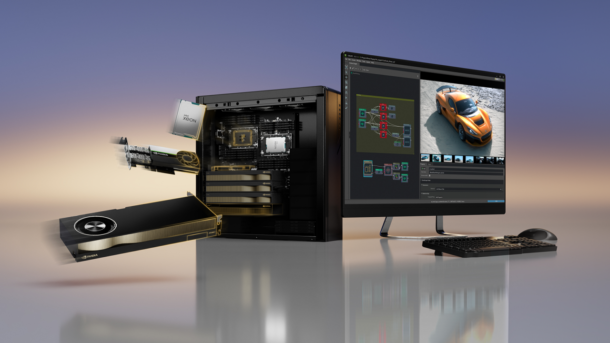Intel and NVIDIA have just announced next-generation workstations. These latest-generation workstations feature Intel’s latest Xeon CPUs, and NVIDIA’s latest RTX 6000 Ada GPUs, together with NVIDIA SmartNICs (network interface controllers).
Redefined Workstations
AI-augmented applications, digital twins, photorealistic rendering, simulation, and other technologies are helping professionals achieve business-critical results from multi-application workflows faster than ever. However, running these data-intensive workflows, and sharing data across geographically dispersed teams, requires plenty of processing power.
To meet this demand, computers need high-powered CPUs, GPUs, and advanced, high-speed networking capabilities. Intel and Nvidia are combining some of their latest processors to power new desktop workstations. These can handle some of the most demanding applications. Roger Chandler, Intel’s vice president and general manager of Creator and Workstation Solutions in its Client Computing Group, explains:
“The latest Intel Xeon W processors—featuring a breakthrough new compute architecture—are uniquely designed to help professional users tackle the most challenging current and future workloads. Combining our new Intel Xeon workstation processors with the latest NVIDIA GPUs will unleash the innovation and creativity of professional creators, artists, engineers, designers, data scientists, and power users across the world.”
Next-generation NVIDIA Lovelace GPU
NVIDIA’s revolutionary Ada Lovelace GPU architecture accelerates the power of the NVIDIA RTX platform, significantly enhancing AI performance, data science, graphics, and rendering capability.
It features third-generation ray-tracing cores and fourth-generation tensor (mixed precision) cores. It also offers next-generation CUDA (compute unified device architecture) cores and 48GB of graphics memory.
The RTX 6000 Ada Generation was specifically designed for the next generation of workstation platforms. This makes it ideal for intensive GPU workloads for AEC, manufacturing, the media and entertainment (M&E) industry, and product design.
Next-generation Intel processors
The Intel Xeon W-3400 series microprocessors feature up to 56 cores for advanced multi-threaded workflows. They operate at clock speeds that reach 4.8GHz, with Intel’s Turbo Boost Max Technology 3.0.
The new chip benefits from the shift to Intel’s Gold Cove CPU architecture. This supersedes its 10nm Willow Cove chip architect, with significant clock-speed benefits and support of the latest DDR5 memory.
Part of the same processor family, the Intel Xeon W-2400 CPU offers 24 cores and supports up to two NVIDIA RTX 6000 Ada Generation GPUs.
Intel’s Xeon W series processors are very sophisticated indeed. They all support AVX-512 (Advanced Vector Extensions for X86 processors), DLBoost (deep learning boost) for AI and machine-learning software workflows, and the new AMX (advanced matrix extensions) instruction set.
Availability and Cost
The new generation of workstations are already available for pre-order from Boxx Technologies and HP. W-2400-based machines currently cost upwards of USD 6,000. W-3400 machines are upwards of USD 10,000.
MORE: BOXX Upgrades APEXX W4 Workstation with New Intel Xeon W-3400 Processor
More machines offering similar specifications are expected from other workstation builders also, in due course. Meanwhile, you can find a detailed write-up of Boxx’s next-generation workstations, featuring the aforementioned CPUs and GPUs in these Architosh reports here and here.
